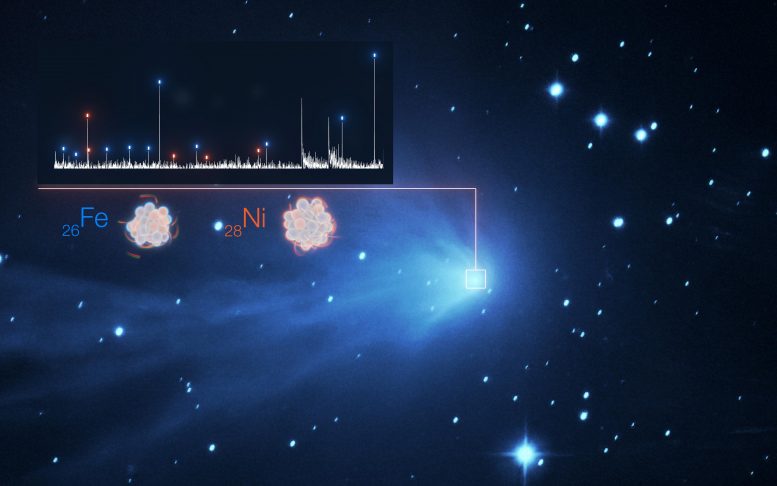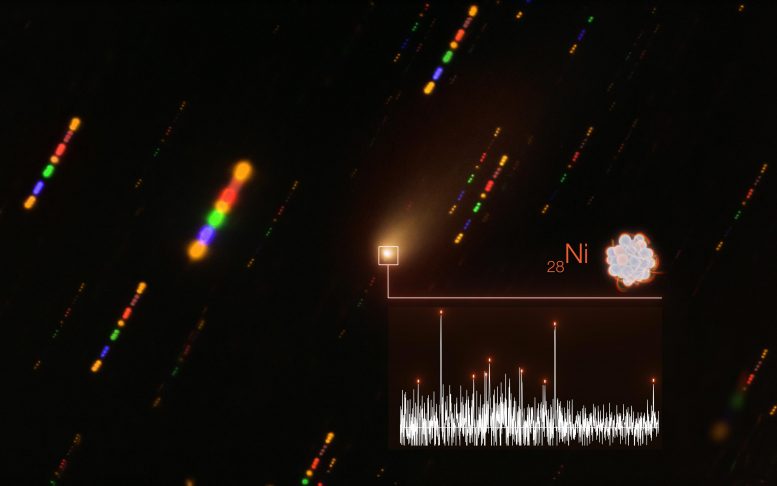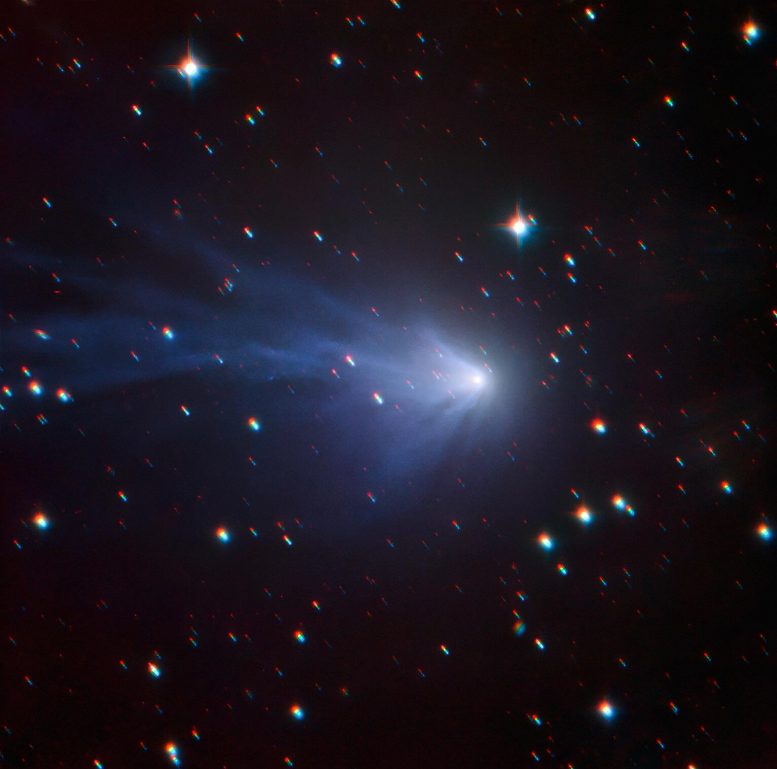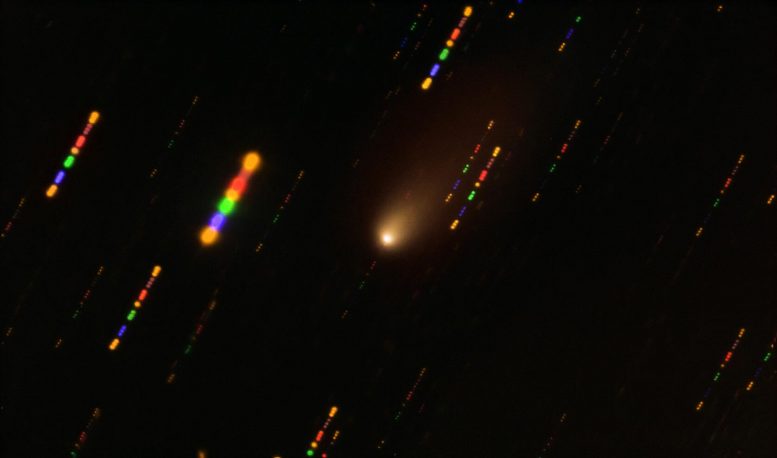
A new study by a Belgian team using data from the European Southern Observatory’s Very Large Telescope (ESO’s VLT) has shown that iron and nickel exist in the atmospheres of comets throughout our Solar System, even those far from the Sun. A separate study by a Polish team, who also used ESO data, reported that nickel vapor is also present in the icy interstellar comet 2I/Borisov. This is the first time heavy metals, usually associated with hot environments, have been found in the cold atmospheres of distant comets.
“It was a big surprise to detect iron and nickel atoms in the atmosphere of all the comets we have observed in the last two decades, about 20 of them, and even in ones far from the Sun in the cold space environment,” says Jean Manfroid from the University of Liège, Belgium, who lead the new study on Solar System comets published today (May 19, 2021) in Nature.
This video starts by showing an animation of comet C/2016 R2 (PANSTARRS), which was done using real images taken by the SPECULOOS telescope at ESO’s Paranal Observatory. The video then zooms in on a blue comet. In a new study done with the UVES instrument on ESO’s Very Large Telescope, a team has spotted heavy metal atoms in the inner atmosphere of the comet, a discovery illustrated at the end of the video. There we see the spectrum of the comet and in particular the iron (Fe, blue) and nickel (Ni, orange) lines, marking the presence of the two elements in the atmosphere of the comet. Credit: ESO/L. Calçada/M. Kornmesser, SPECULOOS Team/E. Jehin, Manfroid, et al.
Astronomers know that heavy metals exist in comets’ dusty and rocky interiors. But, because solid metals don’t usually “sublimate” (become gaseous) at low temperatures, they did not expect to find them in the atmospheres of cold comets that travel far from the Sun. Nickel and iron vapors have now even been detected in comets observed at more than 480 million kilometers from the Sun, more than three times the Earth-Sun distance.

The Belgian team found iron and nickel in comets’ atmospheres in approximately equal amounts. Material in our Solar System, for example that is found in the Sun and in meteorites, usually contains about ten times more iron than nickel. This new result therefore has implications for astronomers’ understanding of the early Solar System, though the team is still decoding what these are.
“Comets formed around 4.6 billion years ago, in the very young Solar System, and haven’t changed since that time. In that sense, they’re like fossils for astronomers,” says study co-author Emmanuel Jehin, also from the University of Liège.
This animation shows an artist’s view of what the surface of the comet might look like. With sizes ranging from a few hundred meters to some kilometers, comets are relatively small rocky and icy objects. The cloud around the comet, its atmosphere or coma, emerges when the comet approaches the Sun in its journey across the Solar System. As the comet heats up, dust and materials from the surface of its nucleus sublimate, forming a sort of very thin atmosphere. Credit: ESO/M. Kornmesser
While the Belgian team has been studying these “fossil” objects with ESO’s VLT for nearly 20 years, they had not spotted the presence of nickel and iron in their atmospheres until now. “This discovery went under the radar for many years,” Jehin says.
The team used data from the Ultraviolet and Visual Echelle Spectrograph (UVES) instrument on ESO’s VLT, which uses a technique called spectroscopy, to analyze the atmospheres of comets at different distances from the Sun. This technique allows astronomers to reveal the chemical makeup of cosmic objects: each chemical element leaves a unique signature — a set of lines — in the spectrum of the light from the objects.

The Belgian team had spotted weak, unidentified spectral lines in their UVES data and on closer inspection noticed that they were signaling the presence of neutral atoms of iron and nickel. A reason why the heavy elements were difficult to identify is that they exist in very small amounts: the team estimates that for each 100 kg of water in the comets’ atmospheres there is only 1 g of iron, and about the same amount of nickel.
“Usually there is 10 times more iron than nickel, and in those comet atmospheres we found about the same quantity for both elements. We came to the conclusion they might come from a special kind of material on the surface of the comet nucleus, sublimating at a rather low temperature and releasing iron and nickel in about the same proportions,” explains Damien Hutsemékers, also a member of the Belgian team from the University of Liège.
This movie shows changes in comet C/2016 R2 (PANSTARRS) tail. Credit: ESO/SPECULOOS Team/E. Jehin, M. Kornmesser
Although the team aren’t sure yet what material this might be, advances in astronomy — such as the Mid-infrared ELT Imager and Spectrograph (METIS) on ESO’s upcoming Extremely Large Telescope (ELT) — will allow researchers to confirm the source of the iron and nickel atoms found in the atmospheres of these comets.
The Belgian team hope their study will pave the way for future research. “Now people will search for those lines in their archival data from other telescopes,” Jehin says. “We think this will also trigger new work on the subject.”
Interstellar heavy metals
Another remarkable study published today in Nature shows that heavy metals are also present in the atmosphere of the interstellar comet 2I/Borisov. A team in Poland observed this object, the first alien comet to visit our Solar System, using the X-shooter spectrograph on ESO’s VLT when the comet flew by about a year and a half ago. They found that 2I/Borisov’s cold atmosphere contains gaseous nickel.

“At first we had a hard time believing that atomic nickel could really be present in 2I/Borisov that far from the Sun. It took numerous tests and checks before we could finally convince ourselves,” says study author Piotr Guzik from the Jagiellonian University in Poland. The finding is surprising because, before the two studies published today, gases with heavy metal atoms had only been observed in hot environments, such as in the atmospheres of ultra-hot exoplanets or evaporating comets that passed too close to the Sun. 2I/Borisov was observed when it was some 300 million kilometers away from the Sun, or about twice the Earth-Sun distance.
This video shows an artist’s view of what the surface of the comet might look like. Credit: ESO/M. Kormesser
Studying interstellar bodies in detail is fundamental to science because they carry invaluable information about the alien planetary systems they originate from. “All of a sudden we understood that gaseous nickel is present in cometary atmospheres in other corners of the Galaxy,” says co-author Michal Drahus, also from the Jagiellonian University.
The Polish and Belgian studies show that 2I/Borisov and Solar System comets have even more in common than previously thought. “Now imagine that our Solar System’s comets have their true analogs in other planetary systems — how cool is that?” Drahus concludes.
More information
This research was presented in two papers to appear in Nature.
The team that carried out the study “Iron and nickel atoms in cometary atmospheres even far from the Sun” by J. Manfroid, D. Hutsemékers and E. Jehin (STAR Institute, University of Liège, Belgium), 19 May 2021, Nature.
DOI: 10.1038/s41586-021-03435-0
The team that carried out the study “Gaseous atomic nickel in the coma of interstellar comet 2I/Borisov” by Piotr Guzik and Michal Drahus (Astronomical Observatory, Jagiellonian University, Kraków, Poland), 19 May 2021, Nature.
DOI: 10.1038/s41586-021-03485-4
ESO is the foremost intergovernmental astronomy organization in Europe and the world’s most productive ground-based astronomical observatory by far. It has 16 Member States: Austria, Belgium, the Czech Republic, Denmark, France, Finland, Germany, Ireland, Italy, the Netherlands, Poland, Portugal, Spain, Sweden, Switzerland, and the United Kingdom, along with the host state of Chile and with Australia as a Strategic Partner. ESO carries out an ambitious program focused on the design, construction, and operation of powerful ground-based observing facilities enabling astronomers to make important scientific discoveries. ESO also plays a leading role in promoting and organizing cooperation in astronomical research. ESO operates three unique world-class observing sites in Chile: La Silla, Paranal, and Chajnantor. At Paranal, ESO operates the Very Large Telescope and its world-leading Very Large Telescope Interferometer as well as two survey telescopes, VISTA working in the infrared and the visible-light VLT Survey Telescope. Also at Paranal ESO will host and operate the Cherenkov Telescope Array South, the world’s largest and most sensitive gamma-ray observatory. ESO is also a major partner in two facilities on Chajnantor, APEX, and ALMA, the largest astronomical project in existence. And on Cerro Armazones, close to Paranal, ESO is building the 39-meter Extremely Large Telescope, the ELT, which will become “the world’s biggest eye on the sky.”
8 Comments
https://sites.hampshire.edu/scienceandislamvideoportal/video/iron-in-the-quran/
Pseudoscience and superstition combined – those are myth texts. Nickel was discovered by a [compatriot] Swede, Axel Fredrik Cronstedt, in the mineral niccolite (NiAs) in 1751.
Comets are electromagnetic phenomenon. It’s ridiculous that our “finest” scientists can’t seem to comprehend this most obvious fact. Why is this dis missed so out of hand?
I think they have an idea of this otherwise they wouldn’t be so blindly adamant.
It isn’t dismissed out of hand but out of many years hard work observing them. For instance, finding heavy metals in their spectra that sublimates at the observed temperatures showing it isn’t much of plasma physics at the comet body. (The tail can become ionized by solar wind and photo dissociation, but that is a side effect.)
They are experts, you are proposing a known pseudoscience. Guess what we read? Yes, the article.
No surprise, it’s all electric. They have a different charge and as they approach the sun they change by blasting off ions. Silly they thought they were snowballs.
They are experts, you are proposing a known pseudoscience. Guess what we read? Yes, the article.
I see Electric Universe folks are out here in force. Thus taking my thoughts with them. Now if we could just ween them off the government tit and send them back to school on their own dollar to find out it’s Electric Magnetism that is the force. The “Plasma” they enjoy is only their gas they keep spewing out there.
More interesting detail here: https://www.chemistryworld.com/news/surprise-as-nickel-vapour-is-found-in-comet-tails-far-too-cold-for-metal-sublimation/4013724.article .
“Mathematical modelling convinced the researchers that neutral nickel atoms were indeed being vapourised at 200K.
The researchers postulate that a short-lived molecule – stable in deep space – may photodissociate when exposed to light even at relatively cold temperatures. They do not propose a specific molecule, but researchers from the University of Liège in Belgium observed similar nickel vapour – as well as iron vapour – in luminescence from a number of comets in our own solar system. They suggested a number of possible organic compounds, such as carbonyls and polycyclic aromatic hydrocarbons, could have produced it by photodissociation. If these were also responsible for the emissions from 2I/Borisov, it raises the intriguing possibility of organic chemistry in other planetary systems being similar to our own.”